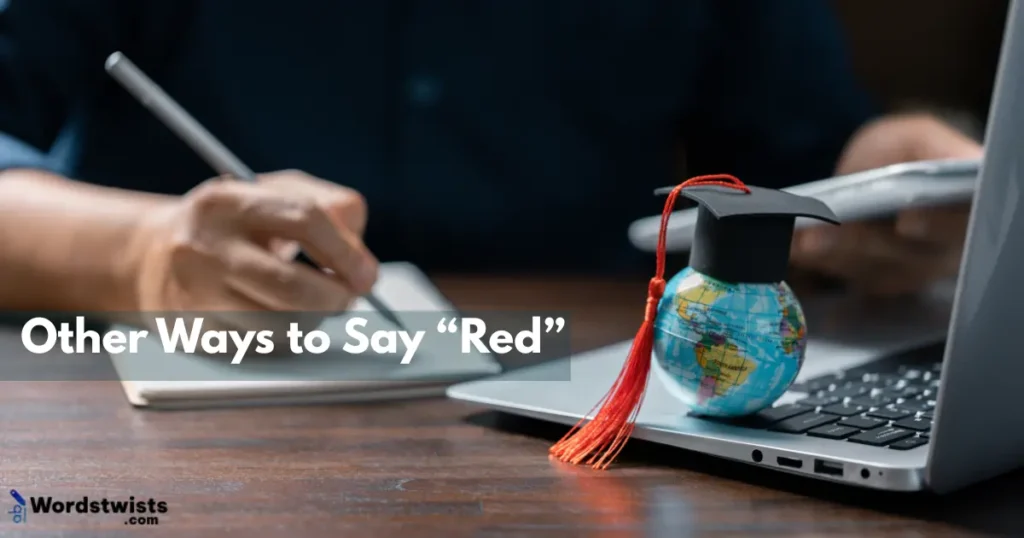We’ve all been there — staring at a sentence and realizing we’ve used the word “red” way too many times. Whether it’s a red rose, red dress, or red sunset, repeating the same word makes writing sound plain. But “red” isn’t just one color — it’s a whole spectrum of feelings, from romance and warmth to power and energy.
In this guide, you’ll find 25 other ways to say “red” that will make your words more colorful and expressive. Each synonym includes an easy explanation, vivid examples, and a quick note on why it works. These alternatives will help your descriptions sparkle, whether you’re writing stories, poems, essays, or just want to sound more creative.
Let’s dive into the shades of red that make language come alive.
Creative Synonyms to to Say “Red”
1. Crimson
Crimson is a deep, rich red with a hint of blue, giving it a cooler and more elegant tone. It often symbolizes passion, royalty, and strength.
Examples:
- Her crimson dress turned every head in the room.
- The sky glowed crimson as the sun sank below the hills.
- His face flushed crimson after the awkward mistake.
- The crimson roses added luxury to the wedding table.
- The knight’s shield gleamed with a crimson crest.
Why It Works:
Crimson adds depth and drama. It works beautifully when you want your descriptions to sound bold, emotional, or elegant.
2. Scarlet
Scarlet is a bright, fiery red with hints of orange. It’s lively, daring, and full of energy.
Examples:
- She wore a scarlet scarf that matched her bold spirit.
- The scarlet leaves fluttered in the autumn wind.
- His scarlet cheeks revealed his nervous excitement.
- The warning light blinked a harsh scarlet across the dashboard.
- A scarlet sunrise lit up the morning sky with warmth.
Why It Works:
Scarlet feels vivid and emotional. It brings energy and warmth to any sentence, making descriptions stand out with power and intensity.
3. Ruby
Ruby is a gem-inspired red, deep and glowing, symbolizing love, wealth, and desire. It’s both romantic and elegant.
Examples:
- Her ruby necklace sparkled under the soft lights.
- The wine glimmered a ruby hue in the glass.
- The ruby curtains gave the room a royal charm.
- His lips were the color of ruby wine.
- The ring held a ruby stone that caught every eye.
Why It Works:
Ruby gives your language a luxurious and romantic touch. It’s perfect for describing beauty, richness, and intensity.
4. Maroon
Maroon is a dark brownish-red that feels warm, earthy, and mature. It often carries a sense of calm, depth, or wisdom.
Examples:
- He wore a maroon jacket that looked timeless and classy.
- The maroon leaves signaled the start of fall.
- The walls were painted a soft maroon tone for a cozy feel.
- Her maroon lipstick added quiet confidence.
- The team’s maroon banner waved proudly at the game.
Why It Works:
Maroon works well when you want to sound grounded and sophisticated. It’s not loud but full of character.
5. Burgundy
Burgundy is a deep red with purple undertones, named after the famous French wine region. It feels rich, classy, and a bit mysterious.
Examples:
- Her burgundy dress shimmered beautifully in the candlelight.
- The car’s burgundy paint gave it a luxurious look.
- He poured a glass of burgundy wine and smiled.
- The room was accented with burgundy cushions and gold lamps.
- The burgundy sunset faded into night.
Why It Works:
Burgundy blends elegance with warmth. It’s a great word when you want to sound polished or refined.
6. Cherry
Cherry is a bright, playful red that feels sweet, youthful, and lively — just like the fruit it’s named after.
Examples:
- She smiled, wearing cherry lipstick that matched her cheerful vibe.
- The car gleamed in a shiny cherry red finish.
- They sat under a cherry tree heavy with blossoms.
- His jacket was a cherry shade, impossible to miss.
- The cupcakes were topped with a single cherry each.
Why It Works:
Cherry adds a fresh and friendly feeling to your writing. It’s perfect for describing things that feel fun, charming, or full of life.
7. Rose
Rose is a soft, gentle red with hints of pink. It’s elegant, romantic, and timeless.
Examples:
- Her rose-colored dress looked graceful in the evening light.
- The rose petals covered the path in beauty.
- His cheeks turned rose when she smiled at him.
- The perfume carried a rose scent that lingered.
- The sky glowed rose gold before sunrise.
Why It Works:
Rose creates a delicate and emotional tone. It’s great for love scenes, soft imagery, or calm emotions.
Read more: Creative Ways to Say Thanks & Show Appreciation
8. Ruby Red
Ruby Red is a deep, gem-like shade that suggests luxury, passion, and intensity.
Examples:
- The sports car was painted a glowing ruby red.
- Her ruby red lips were impossible to ignore.
- The ruby red curtains gave the theater a royal charm.
- The drink shimmered a ruby red hue under the lights.
- He gifted her a ruby red stone for their anniversary.
Why It Works:
Ruby Red shines with energy and emotion. It’s bold, eye-catching, and perfect for vivid, passionate moments.
9. Mahogany
Mahogany is a reddish-brown tone that feels earthy, warm, and mature. It’s often linked to wood, depth, and comfort.
Examples:
- The mahogany furniture gave the room a classic look.
- His hair had a soft mahogany tint in the sunlight.
- The mahogany floor glowed with polish.
- Her mahogany eyes held a quiet strength.
- The cabin was built with mahogany logs that smelled of nature.
Why It Works:
Mahogany adds warmth and natural elegance. It’s ideal when you want to sound rich without being too bright.
10. Garnet
Garnet is a deep red with hints of brown or purple, named after a gemstone. It’s mysterious, royal, and slightly dramatic.
Examples:
- She wore a garnet necklace that sparkled like fire.
- The garnet wine swirled dark and rich in the glass.
- His coat was a garnet shade, sleek and stylish.
- The painting used garnet tones for emotional depth.
- The candlelight reflected off her garnet earrings.
Why It Works:
Garnet adds a touch of mystery and power. It’s elegant and feels more unique than simply saying “red.”
11. Blood Red
Blood Red is a dark, intense red associated with life, danger, and passion. It’s raw and emotional.
Examples:
- The moon hung low and blood red in the night sky.
- He signed the letter with blood red ink.
- Her blood red nails looked fierce and confident.
- The sunset turned the clouds blood red.
- The warrior’s cloak was blood red, symbolizing courage.
Why It Works:
This word brings drama and emotion. It’s strong, vivid, and instantly grabs attention.
12. Coral
Coral is a soft red-orange that feels tropical, feminine, and fresh. It’s bright but gentle.
Examples:
- She wore a coral blouse that glowed in the sunlight.
- The coral reef shimmered under the clear sea.
- Her coral lipstick gave her face warmth.
- The room had coral curtains that brightened the mood.
- The flowers bloomed in a coral shade of beauty.
Why It Works:
Coral adds a friendly and cheerful tone. It’s ideal for light, happy, or colorful scenes.
13. Brick Red
Brick Red is a warm, earthy red that feels solid and rustic. It’s strong but not flashy.
Examples:
- The cottage had brick red walls and white windows.
- He wore a brick red sweater perfect for fall.
- The path was made of brick red tiles.
- The painter added a brick red tint for depth.
- Her brick red lipstick gave her a grounded elegance.
Why It Works:
Brick Red sounds natural and cozy. It works well for describing textures, homes, and autumn tones.
14. Fire Engine Red
Fire Engine Red is a bright, bold red that screams energy and attention. It’s confident and impossible to ignore.
Examples:
- The fire engine red car stood out in traffic.
- She painted her nails fire engine red for fun.
- His fire engine red tie added a pop of color.
- The fire engine red door gave the house personality.
- The toy truck was a classic fire engine red.
Why It Works:
This shade is playful and powerful. It’s perfect for describing things that grab attention and show personality.
15. Berry
Berry is a soft red with pink and purple tones, inspired by fruits like raspberries or strawberries.
Examples:
- Her berry lipstick looked natural yet bold.
- The berry-colored blanket warmed the whole room.
- She baked a berry tart full of rich color.
- The artist used berry shades to paint the flowers.
- He smiled, sipping his berry smoothie.
Why It Works:
Berry feels modern, soft, and appealing. It’s great for fashion, design, and lifestyle writing.
See Also: Other Ways to Say “Self-Care”
16. Wine
Wine is a deep, muted red that feels romantic, rich, and calm — just like a fine drink.
Examples:
- She chose a wine-colored dress for the evening.
- The walls were painted a cozy wine hue.
- His tie matched the wine velvet on the chair.
- The sunset faded into a wine shade of red and purple.
- The room smelled of wine and wood after dinner.
Why It Works:
Wine adds depth and sophistication. It fits well in romantic or mature descriptions.
17. Rust
Rust is a reddish-brown tone that feels aged, natural, and warm. It brings a rustic charm to writing.
Examples:
- The rust-colored leaves covered the ground.
- His rust jacket looked perfect for fall.
- The old gate showed rust stains from years of rain.
- She decorated with rust and gold accents.
- The rust sunset glowed behind the hills.
Why It Works:
Rust gives a sense of nature and time. It’s great for earthy or nostalgic moods.
18. Carmine
Carmine is a vivid red pigment with a hint of pink or purple, often linked to art and beauty.
Examples:
- The artist mixed carmine paint to highlight the roses.
- Her carmine lipstick made her look radiant.
- The carmine fabric shimmered in the spotlight.
- The bird’s carmine feathers glowed under the sun.
- He painted the door a bold carmine shade.
Why It Works:
Carmine sounds artistic and rich, adding creativity and flair to your descriptions.
19. Vermilion
Vermilion is a bright red-orange that feels ancient, vibrant, and confident. It’s a color of celebration and power.
Examples:
- The temple’s roof was painted in vermilion.
- Her vermilion sari sparkled under the lights.
- The vermilion sunset reflected across the lake.
- The dragon’s eyes glowed vermilion in the firelight.
- He used vermilion ink to sign his art.
Why It Works:
Vermilion has history and boldness. It’s perfect when you want a word that feels bizarre and rich.
20. Blush
Blush is a soft, pinkish red that feels gentle, romantic, and sweet.
Examples:
- Her cheeks turned a light blush when he complimented her.
- The blush curtains gave the room warmth.
- She chose a blush gown for her wedding.
- The blush flowers looked delicate in the vase.
- The sky turned blush pink at dawn.
Why It Works:
Blush gives a tender and emotional feel. It’s lovely for soft moments and romantic imagery.
21. Sangria
Sangria is a wine-inspired red that feels festive, fruity, and rich.
Examples:
- The sangria dress looked perfect for a summer evening.
- They shared a pitcher of sangria under the stars.
- The painter used sangria tones for the sunset.
- Her nails were painted a deep sangria red.
- The sangria sofa gave the room a cozy vibe.
Why It Works:
Sangria adds warmth and joy. It’s a lively word that brings energy to any scene.
22. Cerise
Cerise is a bright pinkish-red that feels playful and youthful.
Examples:
- Her cerise jacket stood out in the crowd.
- The cerise flowers added cheer to the garden.
- She smiled, wearing cerise lipstick.
- The ribbon was tied in a cerise bow.
- The cerise glow filled the sky after sunset.
Why It Works:
Cerise adds color and character. It’s bold but fun, making writing sound lively and modern.
23. Claret
Claret is a dark, wine-like red, often used in British English. It’s sophisticated and subtle.
Examples:
- He wore a claret suit that oozed style.
- The claret curtains framed the old windows.
- She sipped a glass of claret wine thoughtfully.
- The artist mixed claret paint for depth.
- The claret upholstery made the room elegant.
Why It Works:
Claret adds a refined, mature tone. It’s perfect for classic or vintage-style writing.
24. Raspberry
Raspberry is a bright red-pink that feels fun, bold, and tasty.
Examples:
- The raspberry ice cream melted in the sun.
- She wore a raspberry skirt that stood out.
- His tie was a striking raspberry shade.
- The raspberry flowers covered the fence.
- The dessert was topped with fresh raspberries.
Why It Works:
Raspberry is vivid and friendly, adding a pop of personality to your language.
25. Pomegranate
Pomegranate is a deep, juicy red symbolizing vitality and beauty.
Examples:
- The pomegranate seeds glistened like jewels.
- She chose a pomegranate dress for the gala.
- The walls were painted a bold pomegranate hue.
- The artist blended pomegranate tones for the background.
- The sunset glowed a pomegranate red.
Why It Works:
Pomegranate combines richness and emotion. It’s a perfect closing shade that feels both strong and beautiful.
Conclusion
You don’t have to stick with plain “red.” Each shade — from crimson to pomegranate — tells a slightly different story. Using these creative synonyms will make your writing more vivid, emotional, and memorable.
Whether you’re describing a romantic dress, a sunset sky, or a moment of passion, the right shade of red helps readers see and feel your words. So explore, experiment, and let your language glow with color.

I’m Leo Knox, the wordplay wizard behind WordsTwists.com where I turn everyday meanings into funny, clever, and creative twists. If you’re tired of saying things the boring way, I’ve got a better (and funnier) one for you!


